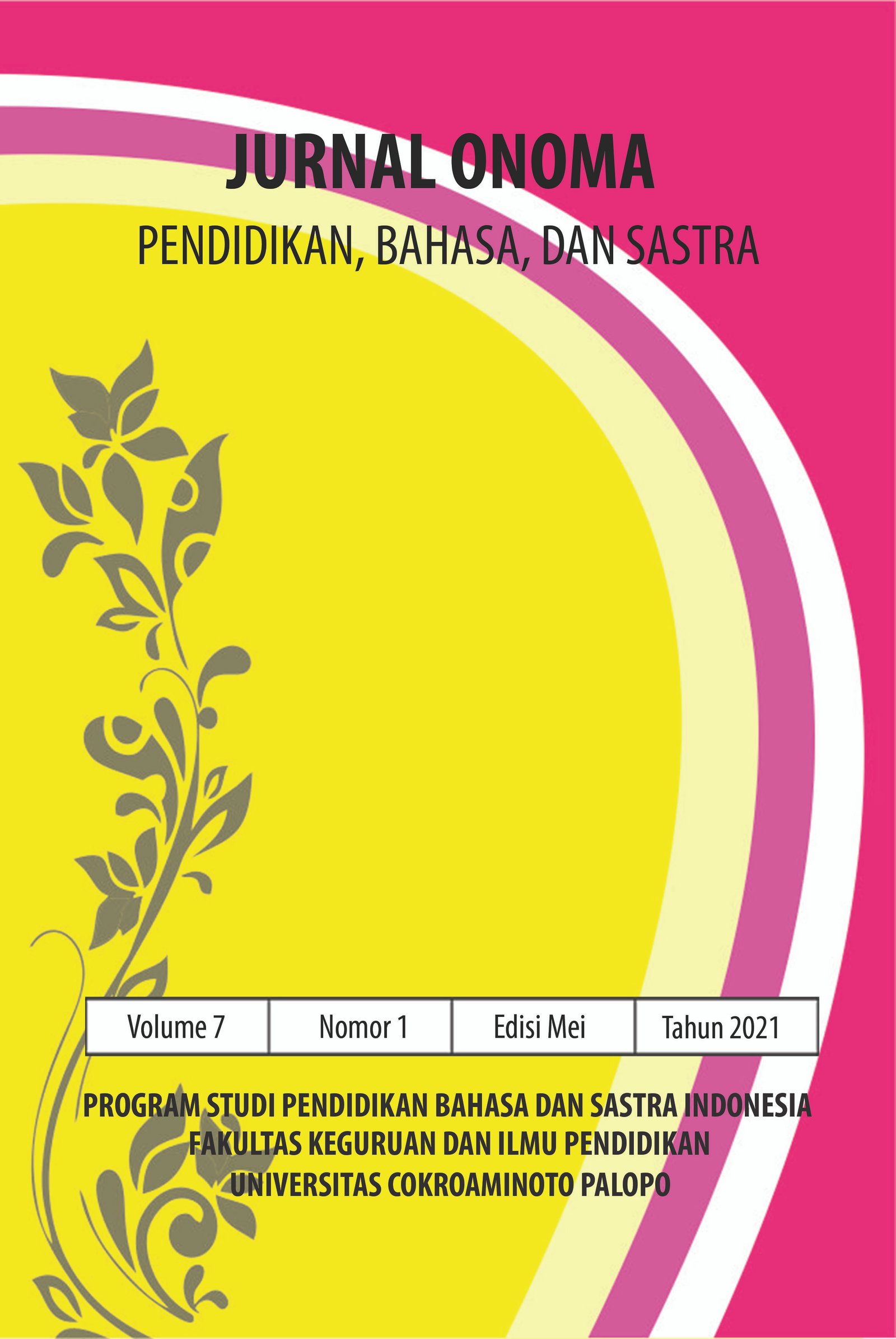Exploring Trends in EFL Students Theses from 2014 to 2018
https://doi.org/10.30605/onoma.v7i1.605
Keywords:
thesis, EFL students, research theme, research methodAbstract
This study aims to explore the themes and methods most often applied by EFL students in their thesis. Sampling is done randomly by collecting theses submitted by students from five consecutive years (2014 – 2018). The data obtained is entered into several tables and graphs, followed by several descriptions of the values contained in the table or graph. This research shows the increase and decrease of student interest regarding the selection of themes and methods they used in their theses. The most widely used theme is vocabulary, and the most frequently used research method is pre-experimental.
Downloads
References
Aditomo, A., & Hasugian, E. J. (2018). Indonesian Adolescents’ EFL Reading Comprehension: Gender Differences and the Influence of Parental Background. Indonesian Journal Of Applied Linguistics, 8(2). http://ejournal.upi.edu/index.php/IJAL/article/view/13279 DOI: https://doi.org/10.17509/ijal.v8i2.13279
Akkoç, A. B., Qin, J., & Karabacak, E. (2018). The Effects of Explicit Instruction of Formulaic Language on EFL Argumentative Writing Quality. Indonesian Journal of Applied Linguistics, 8(2): 358–68. https://doi.org/10.17509/ijal.v8i2.13282 DOI: https://doi.org/10.17509/ijal.v8i2.13282
Dahir, D. (2018). Meningkatkan Kemampuan Menyimak (Listening Skill) Peserta Didik Kelas XII Sma Negeri 2 Kampar Melalui Pronunciation ‘Odd One Out’ Games Pada Teks Explanation Tahun Pelajaran 2017/2018. Jurnal Pendidikan Tambusai, 2(6), 1384–1400.
Ferdiansyah, S. (2018). Collaborative Narrative Writing: A Digital Photography Task in an Indonesian Islamic Secondary School. Indonesian Journal of Applied Linguistics, 8(2), 303–15. https://doi.org/10.17509/ijal.v8i2.13277 DOI: https://doi.org/10.17509/ijal.v8i2.13277
Juanggo, W. (2018). Investigating lexical diversity and lexical sophistication of productive vocabulary in the written discourse of Indonesian EFL learner. Indonesian Journal of Applied Linguistics, 8(2), 303-15. https://doi.org/10.17509/ijal.v8i2.13277 DOI: https://doi.org/10.17509/ijal.v8i1.11462
Kurniawan, E., & Parwati, E. (2018). The Effect of a Narrative Structure and English Proficiency on University Students’ Speaking Performance: Pausing Patterns. Indonesian Journal of Applied Linguistics, 8(2). DOI: https://doi.org/10.17509/ijal.v8i2.13306
Nugraha, G. M., Marmoah, S. & Kurniati, E. (2018). The Use of English Comics To Improve Students’ Speaking Ability By Storytelling At Second Grade Students’ At Smp N 8 Batanghari Jambi In Academic Year 2016/2017. JELT : Journal of English Language Teaching, 2(1), 162–70.
Ozmen, K. S., Cephe, P. T., Kinik, B. (2016). Trends in Doctoral Research On English Language Teaching in Turkey. (Online). https://files.eric.ed.gov/fulltext/EJ1115055.pdf
Putri, R. T., Marmuah, S., & Kurniati, E. (2018). An Analysis Of Students’ Speaking Grammatical Errors At The Second Grade Sma N 10 Jambi Academic Year 2017/2018. Journal of English Language Teaching, 2. https://jelt.unbari.ac.id/index.php/jelt/article/download/18/18
Stephens, M., & Kaiser, M. R. (2018). A Comparison of Visual and Audio Scaffolds in L2 English Reading. Indonesian Journal of Applied Linguistics, 8(2). http://ejournal.upi.edu/index.php/IJAL/article/view/13303 DOI: https://doi.org/10.17509/ijal.v8i2.13303
Yanto, E. S., & Nugraha, S. I. (2018). Video Viewing as a Mediation of Learning Content-Based Vocabulary: Assisting Students in Understanding Disciplinary Vocabulary in Context. Indonesian Journal of Applied Linguistics, 8(2). http://ejournal.upi.edu/index.php/IJAL/article/view/13278 DOI: https://doi.org/10.17509/ijal.v8i2.13278
Yulisa, D. (2018). Learning to Listen: Listening Strategies and Listening Comprehension of Islamic Senior High School Students. Edukasi: Jurnal Pendidikan Dan Pengajaran, 5(1), 22–30. DOI: https://doi.org/10.19109/ejpp.v5i1.2046
Downloads
Published
How to Cite
Issue
Section
License
In submitting the manuscript to the journal, the authors certify that:
- They are authorized by their co-authors to enter into these arrangements.
- The work described has not been formally published before, except in the form of an abstract or as part of a published lecture, review, thesis, or overlay journal.
- That it is not under consideration for publication elsewhere,
- That its publication has been approved by all the author(s) and by the responsible authorities – tacitly or explicitly – of the institutes where the work has been carried out.
- They secure the right to reproduce any material that has already been published or copyrighted elsewhere.
- They agree to the following license and copyright agreement.
License and Copyright Agreement
Authors who publish with Onoma Journal: Education, Languages??, and Literature agree to the following terms:
- Authors retain copyright and grant the journal right of first publication with the work simultaneously licensed under Creative Commons Attribution License (CC BY 4.0) that allows others to share the work with an acknowledgment of the work's authorship and initial publication in this journal.
- Authors are able to enter into separate, additional contractual arrangements for the non-exclusive distribution of the journal's published version of the work (e.g., post it to an institutional repository or publish it in a book), with an acknowledgment of its initial publication in this journal.
- Authors are permitted and encouraged to post their work online (e.g., in institutional repositories or on their website) prior to and during the submission process, as it can lead to productive exchanges, as well as earlier and greater citation of published work.

















